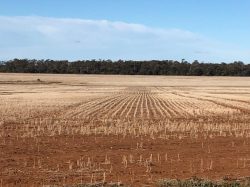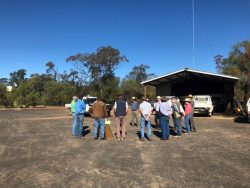Cropping for soil erosion control, North Western NSW
No-till cropping a success story – but what is happening to the soil?
 In recent decades, farmers in the north-west of NSW have adopted and refined various systems of no-tillage cropping which aim at fallow management using herbicides.
In recent decades, farmers in the north-west of NSW have adopted and refined various systems of no-tillage cropping which aim at fallow management using herbicides.
Figure 1 No-till cropping at North Star NSW, June 2019 (S.McInnes-Clarke, DPIE)
This fallow management and low soil disturbance cropping system has resulted in a sound soil erosion strategy, through the protection of the soil from the ravages of a (normally) high-intensity, northern rainfall.
The adoption of no-tillage systems, in conjunction with precision cropping technology, has the following benefits:
- Improved soil structure, due to an improved soil organic carbon status.
- Reduced soil compaction, due to restricted heavy trafficking with all operations, including headers.
- Enhanced crop root development, due to improved soil porosity and reduced bulk density.
- Improved water infiltration, especially to depth, resulting in improved fallow-efficiency and a potential yield increase.
- Reduced soil moisture loss, due to factors such as absence of tillage and stubble protection, thereby enabling:
- Improved operational flexibility, such as achieving improved crop emergence in dry times.
- Improved planting timeliness and better utilisation of the seasonal “window”, thus avoiding stress at key crop development stages (heat, frost at flowering etc).
- More cost-effective application of chemicals, such as fertilizers and pesticides, allowing full utilisation of modern sowing and spray technology.
This system, incorporating appropriate rotations of summer and/or winter crops including legumes, also has immediate economic benefits by:
- Improving availability of key nutrients.
- Reducing leaf and soil-borne disease between crops.
- Improving weed management strategies, particularly weed resistance, due to herbicide rotation.
The successful development and wide adoption of these cropping systems over the past three decades is now regarded as essential to address the soil erosion and degradation problems of the earlier traditional tillage “monoculture” practices. Farmers in the region consider that even a partial return to past fallow and cropping management practices, such as strategic tillage, is not a viable consideration for future cropping.
Figure 2 SKN members talking with farmers at North Star, NSW, June 2019 (Credit S.McInnes-Clarke, DPIE)
However, some concerns have recently been expressed by farmers regarding the possible impact of the longer-term use of chemicals (pesticides) on their soils, particularly on the macro-, meso- and micro-biota in the soil. Pesticides encompass three main groups – herbicides, insecticides and fungicides. Of these, the main concern is with herbicides, particularly in relation to increasing resistance to herbicides of a range of common weed species and the increased levels and variety of herbicides required for their control.
Unfortunately, Australian research on the impacts of herbicides on soil biota is limited, particularly in the dryland cropping systems on north-western NSW soils.
Generally, much of the Australian research on this topic, which is either relevant to the northern cropping environment, or may with some qualification be extrapolated to it, comes from a restricted number of researchers including Vadakattu Gupta of CSIRO, Oliver Knox of UNE and Mick Rose of NSW Department of Primary Industries. Relevant publications include:
- Gupta, VSR, Herbicides and Life in the Soil (In Living Soil-Better Soil, CSIRO Land and Water and Land and Water Research and Development Corporation).
- Gupta, Vadakattu and Knox, Oliver (2010) How Best Can We Design Rhizosphere Plant-Microbe Interaction for the Benefit of Plant Growth. Rovira Ryzosphere Symposium, Chapter , pp 11-23.
- Rose, Michael (2016) Impact of Herbicide on Soil Biology and Function (Advances in Agronomy, 136, pp).
To set the scene for further consideration here, the following extract from the summary publication by Gupta (Herbicides and Life in the Soil) provides relevant detail about the environment within the soil which requires careful monitoring and management when pesticides are regularly applied. This is the key soil component – soil biota – its functions, values, and the implied interaction with tillage practices and pesticide application.
“Pesticides are an essential [sic. component] in modern agriculture. In Australia over $800 million is spent each year on pesticides, with 65% of this expenditure on herbicides.
Many herbicides are applied directly to the soil which has led to questions about their impact on the soil biota – the Life in Soil.
Soil biota consist of a diverse range of organisms; both flora (microorganisms) and fauna (animals). These organisms carry out key soil functions and are grouped by both body size and function…. For example, the function of nutrient cycling is carried out by microflora e.g. bacteria, microfauna e.g. protozoa and mesofauna e.g. collembola (springtails).
All the organisms involved in a specific function are grouped and termed a functional group, e.g. nitrification is carried out by nitrifying microorganisms. Agronomic practices which interfere with specific organisms may reduce the output of a functional group but may not cause it to cease. However, this may result in a new population balance which could lead to plant pathogenic organisms becoming dominant.
An understanding of the impact of different herbicides on various soil functions will help farmers work in harmony with the soil biota and minimise the impact of herbicides on these functions”.
At this point it may be advantageous for the reader to refer to a full copy of the Gupta publication from which the above extract comes. The following points, paraphrased from the Gupta publication, may assist the reader as to the current understanding of the subject. However, any extrapolation needs to consider the full context of the data from which it is drawn, and the limitations highlighted within.
Using information from Australian and international research, some generalisations are presented below. It should be noted that a majority of herbicide research is laboratory based and direct transfer of laboratory results to field situations may not be appropriate.
- The appropriate use of herbicides may be less destructive to the soil environment for soil organisms than the traditional weed control techniques of cultivation and stubble burning, if:
- Stubble/organic residues, a major food/carbon source for organisms, are retained.
- Recommended rates of herbicides are not exceeded.
- A “recovery period” for soil biota is allowed between herbicide applications.
- Repeat applications of the same herbicide within a short period are avoided.
- Appropriate herbicide use with stubble retention may be better for soil biota than cultivation and burning, but it does not mean it is good for soil biota. Some research findings have shown increased soil biota activity from some herbicides, as they provide a source of ‘food’ from the herbicide breakdown or plant material killed by the herbicide.
- Soil biota may be affected by herbicide applications either directly (e.g. kills the organisms through contact) or indirectly (impacts on soil temperature due to weed removal, C/N ratio rebalance, sublethal effects on the crop root growth).
- In many cases there are no definitive answers and only limited research work has been carried out in Australia.
- To highlight current research on one commonly used herbicide (Glyphosate), the conclusion was that ‘the impacts on overall microbial biomass and CO2 production, were frequently found to be positive rather than negative, for a single, label application rate’.
- There is little evidence of long-term effects in the use of Glyphosate on soils, although nitrogen fixation in some crops is found to be reduced and, in certain circumstances, pathogen loads may increase. Soil type will influence this outcome.
- Research on other commonly used herbicides produced varying impacts on soil biota, from positive to negative. As most of this research was conducted in laboratory situations, these impacts may be different under field conditions.
- One generalisation which seems common among the limited research data is that sandy soils, with low organic carbon levels and low microbial activity, show greater negative herbicide effects.
- It takes about six weeks for microbial activity to return to normal after the application of herbicide, although this is dependent on the rates used, the climate conditions and the soil type and soil condition. Multiple applications within this time window would be expected to reduce soil biota. One often-stated reason for this situation, is that the herbicides reduce the food source from plant material, rather than a direct effect of the herbicide on soil biota.
- Micro-organisms feed on simple carbon compounds and agrochemicals. Therefore, all herbicides, to a lesser or greater extent, can be used as a food source by soil biota.
- Populations of appropriate microbes must be present for herbicide degradation. In fact, microbial breakdown of herbicides is an important method for their breakdown in soil.
 Soil Knowledge Network Position Statement
Soil Knowledge Network Position Statement
Best practice no till cropping and herbicides
The NSW Soil Knowledge Network:
- Strongly supports the adoption of zero/no-till cropping rotations which include legumes, using precision farming techniques, as the current best practice for profitable and sustainable crop production on a range of soil landscapes in north-western NSW.
- Acknowledges the innovations of farmers, the industry and agencies in supporting the development of these practices.
- Acknowledges the limited but targeted Australian research on the effect of herbicides on soil biota. The results of this research are optimistic, in that they suggest that herbicides have less impact on soil biota than traditional fallow and cropping management practices, which destroy soil carbon and soil biota.
- Acknowledges the importance of organic carbon sources, favourable soil heath and often essential recovery periods for soil biota after herbicide application. This ensures that essential soil biota are maintained and preserved in soils.
- Acknowledges that appropriate (often recommended) minimalist herbicide use in zero/no-till cropping systems appears to have no, or very limited, impact on soil biota.
- Acknowledges the emerging importance of precision-based cropping practices, including application of herbicide, to ensure that weed resistance, modes of herbicide action and variable soil type responses are all fully considered, so as to minimise applications, costs, and impacts on soils.
- Acknowledges that much of the concern surrounding the issue of herbicide impact on soil biota may be minimised by the widespread adoption of fallow management using camera-spray technology. We support the commercial development of new weed control technologies which do not use herbicides, e.g. microwaves and hot water.
- Strongly advocates and supports proposed research on the impact of herbicides on soil biology, and more specifically on the dryland cropping soils in north-western NSW. Where possible, this research should be field, rather than laboratory, based.
- Advocates the development and generation of appropriate extension materials for effective circulation amongst farmers and technicians.
Promoting the importance of soils through knowledge and expertise www.nswskn.com

